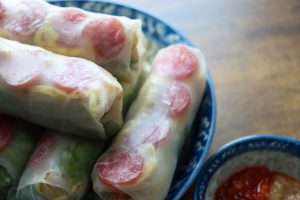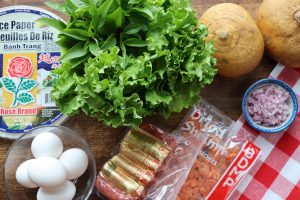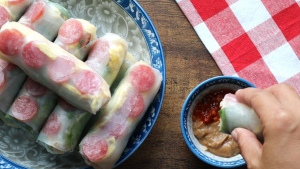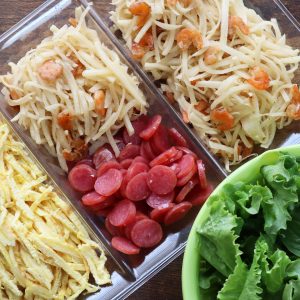Bò Bía (Fresh Vietnamese Spring Roll (with Chinese sausage))

Fresh Spring Roll (with Chinese Sausage), or Bò Bía, is a popular Vietnamese appetizer traditionally served fresh, preferably on the spot. The fillings of Bò Bía typically consist of shredded jicama, julienned carrot, dried shrimp, eggs, Chinese sausage (also called lạp xưởng in Vietnamese), and fresh herbs. What sets Bò Bía apart from other fresh spring rolls is its combination of sweetness and crunchiness from the stir-fried jicama, along with the slight saltiness from the Chinese sausage and dried shrimp.
Bò Bía is believed to have originated in southern Vietnam. The name comes from “bò” (meaning beef) and “bía” (a colloquial term for roll or wrap), though it does not actually contain beef. This naming reflects the influence of Chinese cuisine, where similar rolls are popular.
As a child in Vietnam, I enjoyed Bò Bía for its colourful composition: red from the Chinese sausage, yellow from the eggs, orange from the dried shrimp and carrots, and green from the fresh herbs. The dish is simple to make with minimal cooking involved. Bò Bía is also a healthier option compared to fried spring rolls, offering an elegant balance of proteins and vegetables.
Here are a few notes on my Fresh Spring Roll (with Chinese Sausage) or Bò Bía recipe:
- Many Bò Bía recipes include carrot, but I omit this ingredient in my version to simplify the preparation process. The rolls still taste delicious without it.
- I highly recommend serving Bò Bía within a few hours of making the rolls. These are fresh rolls and are best enjoyed immediately, as they are not meant to be refrigerated or consumed the next day.
Q&As on Fresh Spring Roll (with Chinese Sausage) or Bò Bía

1. What is the main difference between Bò Bía and other types of Vietnamese spring rolls?
The main difference is that Bò Bía is served fresh and not fried. It features a unique combination of ingredients like shredded jicama, julienned carrot, dried shrimp, Chinese sausage, and fresh herbs. Unlike other spring rolls, Bò Bía has a distinctive sweetness and crunchiness from the stir-fried jicama, along with a slight saltiness from the Chinese sausage and dried shrimp.
2. What fresh herbs and vegetables do I use with Bò Bía?
For Bò Bía, a variety of fresh herbs and vegetables enhance the flavour and texture of the rolls. Key ingredients include:
- Mint: Adds a refreshing, cool flavour.
- Cilantro (Coriander): Provides citrusy, herbal notes.
- Vietnamese Coriander (Rau Răm): Contributes a unique, peppery flavour.
- Thai Basil: Offers a slightly spicy, aromatic taste that complements the other ingredients.
- Lettuce: Provides a crisp, crunchy texture and helps keep the rolls fresh.
These herbs and vegetables are typically used to add freshness and vibrant flavour to the rolls, making them a delicious and balanced dish.
3. What dipping sauce do I use with Bò Bía?
Bò Bía is typically served with a variety of dipping sauces that complement its fresh, vibrant flavours. Common options include:
- Hoisin Sauce: A sweet and savoury sauce that pairs well with the sweet and salty elements of the rolls.
- Peanut Sauce: Made with peanut butter, hoisin sauce, and sometimes coconut milk, this sauce adds a rich, creamy texture.
- Sweet Chili Sauce: Provides a balance of sweetness and mild heat, enhancing the freshness of the rolls.
You can choose one or mix these sauces to suit your taste preferences.

4. Can I make Bò Bía ahead of time?
Bò Bía is best enjoyed fresh and is not ideal for making ahead of time. The rolls should be served within a few hours of preparation to ensure optimal freshness and texture. They are not suitable for refrigeration or consumption the next day as they can become soggy and lose their crunch.
5. How do you pronounce “Bò Bía?”
The pronunciation of “Bò Bía” in Vietnamese is:
- Bò: Pronounced like “baw” with a soft “b” and an open “aw” sound. The tone is low and level.
- Bía: Pronounced like “bee-uh” with a high, rising tone on “bee” and a slight drop on “uh.”
So, “Bò Bía” sounds like “baw bee-uh,” with the emphasis on the rising tone of “Bía.”

Recipe for Fresh Spring Roll (with Chinese Sausage) or Bò Bía
Ingredients
- 2 medium jicamas
- 75 grams dried shrimp
- 5 Chinese sausages
- 5 eggs
- Shallots (finely chopped)
- Rice paper
- Vegetables: Lettuce, Thai basil
- For seasoning: Salt, MSG (or chicken bouillon powder)
Instructions
- Soak the dried shrimp in a small bowl of water until they become soft and pliable, which usually takes about 20-30 minutes. After soaking, drain the shrimp well.
- In a separate bowl, crack the eggs and beat them thoroughly with a fork or whisk. Add a pinch of salt to the beaten eggs and mix well.
- Peel the jicamas carefully to remove the tough outer skin. Once peeled, slice the jicamas into thin strands.
- Add cooking oil to a large nonstick skillet and heat it over high heat. Add the shallots to the hot skillet and sauté them until they become. Next, add the drained dried shrimp to the skillet, stirring frequently to ensure they cook evenly.
- Add the sliced jicamas to the skillet with the shallots and dried shrimp. Stir well to combine all the ingredients. Season with a bit of salt and a small amount of MSG or chicken bouillon powder to enhance the flavour. Continue to cook, stirring occasionally.
- Cook the jicamas until they become tender, but still retain some crunch. Once cooked to your liking, remove the skillet from the heat and set the mixture aside.
- Use a nonstick skillet for the next step and brush it lightly with cooking oil. Heat it over medium-high heat until the oil is hot. Then pour the beaten eggs into the hot skillet, tilting the pan to spread the eggs into a thin, even layer. Let the eggs cook undisturbed until they are fully set and no longer runny.
- Remove the cooked egg sheet from the skillet and place it on a plate to cool. Repeat the process with the remaining beaten eggs, adding more oil to the skillet as needed to prevent sticking. Once all the egg sheets are cooked, set them aside.
- Thinly slice the egg sheets into ribbons.
- In the same skillet, add a small amount of water and the Chinese sausages. Bring the water to a boil over medium heat and cook the sausages for about 5 minutes.
- After boiling, drain the water from the skillet. Lightly fry the sausages until they are slightly crispy. Once done, remove them from the skillet and set them aside to cool.
- Thinly slice the cooked Chinese sausages into small, bite-sized pieces.
- Wet a piece of rice paper and lay it flat on a clean surface, such as a cutting board or a plate. Place a few leaves of lettuce and Thai basil in the centre of the rice paper. Then, add a portion of the cooked jicamas and shrimp on top of the herbs.
- Add ribbons of egg and slices of Chinese sausage on top of the vegetables. Arrange the ingredients neatly to ensure each roll has a balanced mix of flavours and textures.
- Begin to roll the rice paper tightly around the filling, folding in the sides as you go to create a neat, sealed roll. Press gently to ensure the roll holds together without gaps.
- The rolls are now ready to be enjoyed. Serve them with hoisin peanut sauce or any dipping sauce of your choice.

